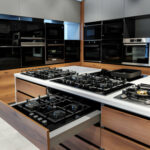
Let us dive into the delightful world of kitchen organization and learn how to keep your pantry clean and well-maintained. Imagine having a pantry full of fresh ingredients, well-organized shelves, and a sense of order that makes cooking a delight. In this guide, we will reveal the tricks to turning your pantry into a foodie’s dream, so that your kitchen is not only well-kept but also serves as a creative inspiration for your next delicious creation.
We will start by learning the secrets of the initial pantry purge, which is saying goodbye to expired goods, clearing out non-essentials, and starting over. Next, we will take a tour of smart shelving options, such as adjustable shelves, clear containers, and labels, which make it easy to find what you need. Finally, we will delve into temperature control, humidity management, and effective inventory practices, which will help you maintain the freshness of your ingredients and avoid pantry chaos. Come along on this culinary adventure where organization and simplicity meet, transforming your kitchen pantry into the ideal place every foodie has always dreamed of.
See also our post on How to Clean and Sanitize Your Child’s Play Kitchen
The Initial Pantry Purge
1. Assessing Expiry Dates
Begin with a thorough examination of all items in your pantry. Check expiration dates to identify and discard any expired or stale products. This step sets the foundation for a fresh and organized pantry space.
2. Categorizing Food Items
Categorize your food items for better organization. Group similar items together, such as grains, canned goods, spices, and baking essentials. This approach streamlines your cooking process and makes it easier to locate ingredients.
3. Decluttering Non-Essential Items
Remove non-essential or rarely used items. Decluttering creates more space for essential ingredients and prevents overcrowding, allowing you to see and access items with ease.
4. Donating Unopened Items
Consider donating unopened and non-expired items that you won’t use. This not only helps those in need but also reduces excess in your pantry, creating a more streamlined and efficient storage space.
5. Cleaning Shelves and Surfaces
Before restocking, clean shelves and surfaces thoroughly. Wipe away dust, crumbs, and spills. A clean foundation ensures that your pantry remains a hygienic and welcoming space for your culinary adventures.
Smart Shelving and Storage Solutions
Adjustable Shelving Systems
Invest in adjustable shelving systems to maximize vertical space. This allows you to customize shelf heights based on the size of your ingredients and kitchen tools, creating a versatile and efficient storage solution.
Clear Containers for Visibility
Use clear containers for storing dry goods. Transparent containers provide visibility, making it easy to identify the contents and monitor ingredient levels. This also prevents the accumulation of half-empty bags and boxes.
Labeling for Easy Identification
Label containers and shelves for easy identification. Clear labels prevent confusion and ensure that every item has its designated place, helping you maintain an organized pantry in the long run.
Utilizing Door Storage
Make use of door storage for small items and spices. Hanging organizers or mounted racks on the pantry door maximizes space and provides quick access to frequently used ingredients without cluttering shelves.
Incorporating Pull-Out Baskets
Consider pull-out baskets for deep shelves. These baskets make it easier to access items stored in the back, eliminating the need to rummage through shelves and helping you maintain an organized pantry effortlessly.
See also our post on Restaurant Kitchen Cleaning: Maintaining Hygiene Standards
Temperature and Humidity Control
Ideal Pantry Temperature
Maintain an ideal pantry temperature to preserve food quality. Most dry goods thrive in cool, dark environments. Avoid placing the pantry near heat sources or in direct sunlight to prevent spoilage and maintain ingredient freshness.
Humidity Monitoring
Monitor humidity levels in your pantry. Excessive humidity can lead to the development of mold and spoilage. Use moisture-absorbing products or consider a dehumidifier for larger pantry spaces to control humidity effectively.
Proper Ventilation
Ensure proper ventilation in the pantry area. Good air circulation prevents the buildup of stale air and discourages the growth of mold. A well-ventilated pantry contributes to a healthier and longer shelf life for your ingredients.
Controlled Lighting
Keep lighting in the pantry controlled. Use LED lights, which emit minimal heat, to avoid temperature fluctuations. Controlled lighting also helps you easily see and identify items, contributing to efficient pantry maintenance.
Periodic Air Circulation
Periodically open the pantry door to allow fresh air circulation. This simple practice helps prevent stale odors and maintains a pleasant atmosphere in the pantry, ensuring that your ingredients remain untainted.
Efficient Inventory Management
Regular Pantry Audits
Conduct regular pantry audits to assess inventory levels. This prevents overstocking and helps you plan meals based on what you already have, reducing food waste and ensuring that ingredients are used before expiration.
First-In-First-Out (FIFO) System
Implement a First-In-First-Out (FIFO) system for perishable items. Arrange products so that older items are used first, reducing the likelihood of items expiring before use and promoting efficient pantry rotation.
Inventory Tracking Apps
Consider using inventory tracking apps. These apps allow you to scan and log items as you use them, helping you keep track of what needs replenishing and streamlining your grocery shopping experience.
See also our post on Zero-Waste Kitchen Cleaning: Sustainable Solutions for Spills and Stains
Shopping Lists and Meal Planning
Maintain shopping lists and engage in meal planning. Knowing what you need before shopping helps you avoid impulse buys and ensures that your pantry is stocked with ingredients that align with your culinary preferences.
Bulk Buying Strategies
Strategically buy in bulk for frequently used items. This saves money in the long run and reduces packaging waste. Transfer bulk items into labeled containers to maintain a neat and organized pantry.
Pest Prevention and Control
Sealing Cracks and Gaps
Seal any cracks or gaps in the pantry to prevent pests from entering. Use caulk or weather stripping to close off potential entry points, creating a barrier that keeps your pantry pest-free.
Regular Cleaning to Deter Pests
Regularly clean the pantry to deter pests. Crumbs and spills attract unwanted visitors, so a thorough cleaning routine helps maintain a hygienic environment and keeps pests at bay.
Natural Pest Repellents
Explore natural pest repellents. Items like bay leaves, cinnamon sticks, and peppermint oil are known to deter pests without the use of harmful chemicals, adding an extra layer of protection to your pantry.
Securely Stored Pet Food
If you store pet food in the pantry, ensure it’s securely sealed. Pet food can attract pests, so using airtight containers for pet supplies helps maintain a pest-free pantry environment.
Professional Pest Control Services
If pests persist, consider professional pest control services. Pest control experts can identify and eliminate pest infestations, safeguarding your pantry and preserving your food items.
See also our post on How to Properly Clean and Disinfect the Kitchen Sink
Conclusion
Congratulations on starting the journey to design and care for a pantry that captures the essence of your passion for cooking! A well-kept pantry makes cooking more enjoyable and guarantees that your ingredients stay accessible and fresh. If you follow the thorough advice provided in this guide, you will be well on your way to turning your kitchen pantry into a foodie’s dream—a place where organization and inspiration come together and every dish is a pleasure to prepare. Happy cooking!







